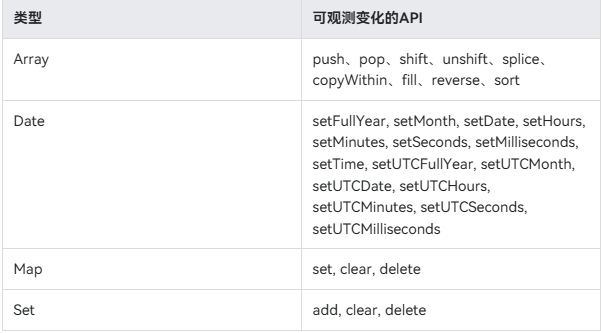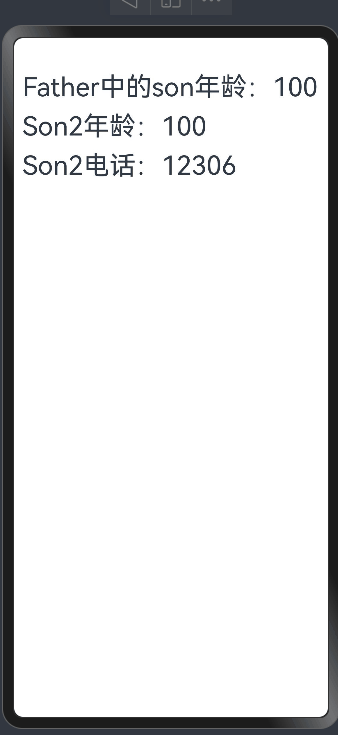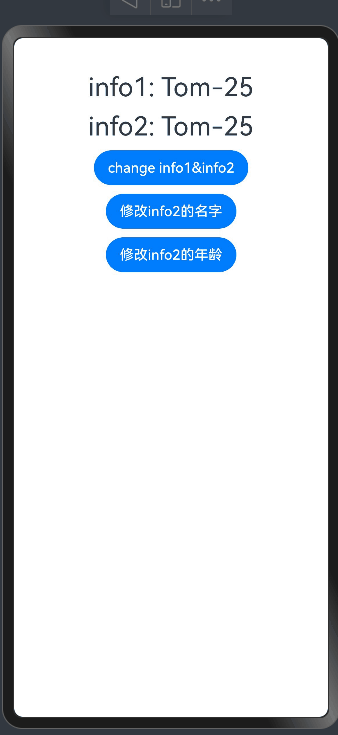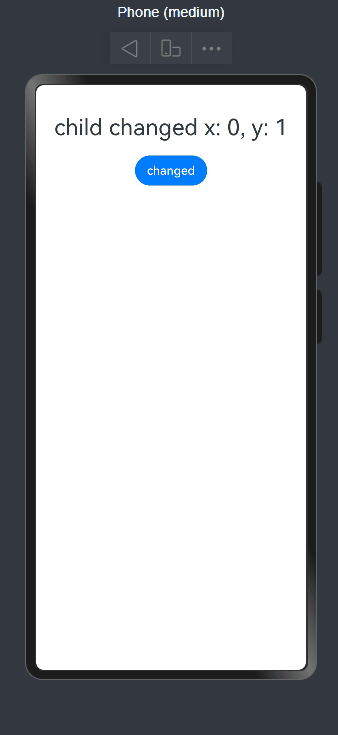HarmonyOS鸿蒙NEXT状态管理V2版本使用详解
HarmonyOS鸿蒙NEXT状态管理V2版本使用详解
概述
现阶段状态管理V2版本还在试用阶段,但是切实解决了很多在项目中使用V1导致的痛点问题,比如:
- 同一数据被多视图代理时,无法同步数据修改。
- 无法做到深度观测和深度监听。
- 更新对象中某个数据时,会导致整个对象属性都刷新,导致程序运行缓慢。
状态管理V2版 装饰器总览
@ObservedV2:装饰class,使得装饰的class具有深度监听的能力。[@Trace](/user/Trace):只能在@ObservedV2装饰的class中使用,被装饰的属性具有深度观测的能力。@ComponentV2:装饰页面或者自定义组件。确定struct中可以使用V2版的装饰器。[@Local](/user/Local):装饰的变量为当前组件的内部状态,无法从外部初始化。[@Param](/user/Param):装饰的变量为组件的输入,可以接受从外部传入初始化并同步。[@Once](/user/Once):装饰的变量仅初始化时同步一次,需要与[@Param](/user/Param)一起使用。[@Event](/user/Event):装饰方法类型,作为组件输出,可以通过该方法影响父组件中变量。[@Monitor](/user/Monitor):装饰器用于@ComponentV2装饰的自定义组件或@ObservedV2装饰的类中,能够对状态变量进行深度监听。[@Provider](/user/Provider)和[@Consumer](/user/Consumer):用于跨组件层级双向同步。@Computed:计算属性,在被计算的值变化的时候,只会计算一次。主要应用于解决UI多次重用该属性从而重复计算导致的性能问题!!语法:双向绑定语法糖。
class的深入监测
使用@ObservedV2和[@Trace](/user/Trace)两种装饰器,实现对属性修改的观测能力。具有以下特点:
- 被
[@Trace](/user/Trace)装饰器装饰的属性变化时,仅会通知属性关联的组件进行刷新。 @ObservedV2的类实例目前不支持使用JSON.stringify进行序列化。
@Trace可装饰的变量
class中成员属性。属性的类型可以为number、string、boolean、class、Array、Date、Map、Set等类型。
@Trace可观测API变化

使用
新建三个class,Father,Son,Son2。
- Son类被
@ObservedV2装饰器装饰,age属性被[@Trace](/user/Trace)装饰器装饰。因此,age属性的修改会引起UI更新。 - Father类没有被
@ObservedV2装饰器修饰。 - Son2类继承Son类,有一个没有被
[@Trace](/user/Trace)装饰器装饰的Telephone属性。
实现效果

自定义组件
使用@ComponentV2装饰器结合[@Local](/user/Local)、[@Param](/user/Param)、[@Once](/user/Once)、[@Event](/user/Event)、[@Provider](/user/Provider)、[@Consumer](/user/Consumer)等装饰器,实现自定义组件的状态观测。
@Local
使用[@Local](/user/Local)装饰对象,可以达到观测对象本身变化的效果。具有以下特点:
- 被
[@Local](/user/Local)装饰的变量无法从外部初始化,因此必须在组件内部进行初始化。 [@Local](/user/Local)支持观测number、boolean、string、Object、class等基本类型以及Array、Set、Map、Date等内嵌类型。[@Local](/user/Local)支持null、undefined以及联合类型。- 当装饰的变量类型是内置类型时,可以观察到变量整体赋值以及通过API调用带来的变化。
代码实现
@Entry
@ComponentV2
struct ComponentPage {
info1: Info = new Info("Tom", 25);
[@Local](/user/Local) info2: Info = new Info("Tom", 25);
build() {
Column({ space: 10 }) {
Text(`info1: ${this.info1.name}-${this.info1.age}`).fontSize(30) // Text1
Text(`info2: ${this.info2.name}-${this.info2.age}`).fontSize(30) // Text2
Button("change info1&info2")
.onClick(() => {
this.info1 = new Info("Lucy", 18); // Text1不会刷新
this.info2 = new Info("Lucy", 18); // Text2会刷新
})
Button("修改info2的名字")
.onClick(() => {
this.info2.name = "zzx" // Text2会刷新
})
Button("修改info2的年龄")
.onClick(() => {
this.info2.age++; // Text2不会刷新
})
}
.width("100%")
.height("100%")
}
}
@ObservedV2
class Info {
[@Trace](/user/Trace) name: string;
age: number;
constructor(name: string, age: number) {
this.name = name;
this.age = age;
}
}
实现效果
- 点击“change info1&info2”按钮,Text1不会刷新,Text2会刷新。
- 点击“修改info2的名字” 按钮,Text2会刷新。
- 点击“修改info2的年龄” 按钮,Text2不会刷新。

@Param
具有以下特点:
[@Param](/user/Param)装饰的变量支持本地初始化,但是不允许在组件内部直接修改变量本身。- 被
[@Param](/user/Param)装饰的变量能够在初始化自定义组件时从外部传入,当数据源也是状态变量时,数据源的修改会同步给[@Param](/user/Param)。 [@Param](/user/Param)可以接受任意类型的数据源,包括普通变量、状态变量、常量、函数返回值等。[@Param](/user/Param)装饰的变量变化时,会刷新该变量关联的组件。[@Param](/user/Param)支持观测number、boolean、string、Object、class等基本类型以及Array、Set、Map、Date等内嵌类型。- 当装饰简单类型时,对变量的整体改变能够观测到;当装饰对象类型时,仅能观测对象整体的改变;当装饰数组类型时,能观测到数组整体以及数组元素项的改变;当装饰Array、Set、Map、Date等内嵌类型时,可以观测到通过API调用带来的变化。
[@Param](/user/Param)支持null、undefined以及联合类型。
代码实现
@Entry
@ComponentV2
struct ParamPage {
[@Local](/user/Local) infoList: ParamInfo[] =
[new ParamInfo("Alice", 8, 0, 0), new ParamInfo("Barry", 10, 1, 20), new ParamInfo("Cindy", 18, 24, 40)];
build() {
Column({ space: 10 }) {
ForEach(this.infoList, (info: ParamInfo) => {
MiddleComponent({ info: info })
})
Button("修改")
.onClick(() => {
this.infoList[0] = new ParamInfo("Atom", 40, 27, 90);
this.infoList[1].name = "Bob";
this.infoList[2].region = new Region(7, 9);
})
}
.margin({ left: 10 })
.width("100%")
.height("100%")
.alignItems(HorizontalAlign.Start)
}
}
@ComponentV2
struct MiddleComponent {
[@Param](/user/Param) info: ParamInfo = new ParamInfo("0", 0, 0, 0);
build() {
Column({ space: 10 }) {
Text(`name: ${this.info.name}`).fontSize(30)
Text(`age: ${this.info.age}`).fontSize(30)
SubComponent({ region: this.info.region })
}
.alignItems(HorizontalAlign.Start)
}
}
@ComponentV2
struct SubComponent {
[@Param](/user/Param) region: Region = new Region(0, 0);
build() {
Column() {
Text(`region: ${this.region.x}-${this.region.y}`).fontSize(30)
}
}
}
@ObservedV2
class Region {
[@Trace](/user/Trace) x: number;
[@Trace](/user/Trace) y: number;
constructor(x: number, y: number) {
this.x = x;
this.y = y;
}
}
@ObservedV2
class ParamInfo {
[@Trace](/user/Trace) name: string;
[@Trace](/user/Trace) age: number;
[@Trace](/user/Trace) region: Region;
constructor(name: string, age: number, x: number, y: number) {
this.name = name;
this.age = age;
this.region = new Region(x, y);
}
}
实现效果

@Once
可以对[@Param](/user/Param)装饰器的能力进行修改,具有以下的特点:
[@Once](/user/Once)必须搭配[@Param](/user/Param)使用,单独使用或搭配其他装饰器使用都是不允许的。[@Once](/user/Once)不影响[@Param](/user/Param)的观测能力,仅针对数据源的变化做拦截。[@Once](/user/Once)与[@Param](/user/Param)搭配使用时,可以在本地修改[@Param](/user/Param)变量的值。
@Event
使用[@Event](/user/Event)装饰器装饰回调方法,可以实现子组件对父组件传递的[@Param](/user/Param)装饰的变量进行修改。类似子组件定义了一个委托函数,然后在父组件初始化的时候,对子组件的委托函数进行定义,子组件可以使用委托函数来实现想要的效果。
使用场景
更改父组件中的变量
@Entry
@ComponentV2
struct EventPage {
[@Local](/user/Local) title: string = "Titile One";
[@Local](/user/Local) fontColor: Color = Color.Red;
build() {
Column() {
Child({
title: this.title,
fontColor: this.fontColor,
changeFactory: (type: number) => {
if (type == 1) {
this.title = "Title One";
this.fontColor = Color.Red;
} else if (type == 2) {
this.title = "Title Two";
this.fontColor = Color.Green;
}
}
})
}
.width("100%")
.height("100%")
}
}
@ComponentV2
struct Child {
[@Param](/user/Param) title: string = '';
[@Param](/user/Param) fontColor: Color = Color.Black;
[@Event](/user/Event) changeFactory: (x: number) => void = (x: number) => {};
build() {
Column({ space: 10 }) {
Text(`${this.title}`)
Button("change to Title Two")
.onClick(() => {
this.changeFactory(2);
})
Button("change to Title One")
.onClick(() => {
this.changeFactory(1);
})
}
}
}
实现效果

@Provider和@Consumer
仅能修饰自定义组件内的属性,不能修饰class的属性。
和V1版本中的@Provide和@Consume有异曲同工之妙,主要用于跨组件层级数据双向同步,但也存在不一样的能力:
@Provider语法
[@Provider](/user/Provider)(alias?: string) varName : varType = initValue
- aliasName?: string,别名,缺省时默认为属性名,向上查找最近的
[@Provider](/user/Provider)。
@Consumer语法
[@Consumer](/user/Consumer)(alias?: string) varName : varType = initValue
- aliasName?: string,别名,缺省时默认为属性名。
使用场景
子组件需要修改父组件的内容,可以使用 [@Provider](/user/Provider)和[@Consumer](/user/Consumer)来实现。
@Entry
@ComponentV2
struct ProviderPage {
[@Local](/user/Local) childX: number = 0;
[@Local](/user/Local) childY: number = 1;
[@Provider](/user/Provider)() onClick1: (x: number, y: number) => void = (x: number, y: number) => {
this.childX += x;
this.childY += y;
}
build() {
Column({ space: 20 }) {
Text(`child changed x: ${this.childX}, y: ${this.childY}`).fontSize(30)
ProviderPageChild()
}
.width("100%")
.height("100%")
}
}
@ComponentV2
struct ProviderPageChild {
[@Consumer](/user/Consumer)() onClick1: (x: number, y: number) => void = (x: number, y: number) => {
};
build() {
Button("changed")
.draggable(true)
.onClick(() => {
this.onClick1(1, 1);
})
}
}
实现效果

@Monitor
- 用来监听状态变量变化,支持在类中与
@ObservedV2、[@Trace](/user/Trace)配合使用。 - 单个
[@Monitor](/user/Monitor)装饰器能够同时监听多个属性的变化,当这些属性在一次事件中共同变化时,只会触发一次[@Monitor](/user/Monitor)的回调方法。 [@Monitor](/user/Monitor)装饰器具有深度监听的能力,能够监听嵌套类、多维数组、对象数组中指定项的变化。对于嵌套类、对象数组中成员属性变化的监听要求该类被@ObservedV2装饰且该属性被[@Trace](/user/Trace)装饰- 在继承类场景中,可以在父子组件中对同一个属性分别定义
[@Monitor](/user/Monitor)进行监听,当属性变化时,父子组件中定义的[@Monitor](/user/Monitor)回调均会被调用。
装饰器参数
字符串类型的对象属性名。可同时监听多个对象属性,每个属性以逗号隔开,例如[@Monitor](/user/Monitor)("prop1", "prop2")。可监听深层的属性变化,如多维数组中的某一个元素,嵌套对象或对象数组中的某一个属性。
[@Monitor](/user/Monitor)("childX")
OnChange(monitor: IMonitor) {
//do something
}
IMonitor类型的变量用作[@Monitor](/user/Monitor)装饰方法的参数。
使用场景
新建MonitorInfo类和被@ObservedV2装饰器装饰并继承MonitorInfo类的MonitorInfo2。
@Entry
@ComponentV2
struct MonitorPage {
[@Local](/user/Local) info: MonitorInfo = new MonitorInfo("Tom", 25);
[@Local](/user/Local) info2: MonitorInfo2 = new MonitorInfo2("zzx", 27, "zhongzx");
[@Monitor](/user/Monitor)("info")
infoChange(monitor: IMonitor) {
console.log(`MonitorInfo change`);
}
[@Monitor](/user/Monitor)("info.name")
infoPropertyChange(monitor: IMonitor) {
console.log(`MonitorInfo name change`);
}
[@Monitor](/user/Monitor)("info2")
info2Change(monitor: IMonitor) {
console.log(`MonitorInfo2 change`);
}
[@Monitor](/user/Monitor)("info2.fullname")
info2PropertyChange(monitor: IMonitor) {
console.log(`MonitorInfo2 fullname change`);
}
build() {
Column({ space: 10 }) {
Text(`name: ${this.info.name}, age: ${this.info.age}`)
Text(`name: ${this.info2.name}, age: ${this.info2.age},fullName:${this.info2.fullname}`)
Button("change info")
.onClick(() => {
this.info = new MonitorInfo("Lucy", 18); // 能够监听到
})
Button("change info.name")
.onClick(() => {
this.info.name = "Jack"; // 监听不到
})
Button("change info2")
.onClick(() => {
this.info2 = new MonitorInfo2("Lucy", 20, "hl"); // 能够监听到
})
Button("change info2.fullName")
.onClick(() => {
this.info2.fullname = "hhl"; // 能够监听到
})
Button("change info2.name")
.onClick(() => {
this.info2.name = "Jack"; // 监听不到
})
}
.width("100%")
.height("100%")
}
}
class MonitorInfo {
name: string;
age: number;
constructor(name: string, age: number) {
this.name = name;
this.age = age;
}
}
@ObservedV2
class MonitorInfo2 extends MonitorInfo {
[@Trace](/user/Trace) fullname: string = "";
constructor(name: string, age: number, fullName: string) {
super(name, age);
this.fullname = fullName;
}
}
实现效果
- 整体替换的时候,都可以监测到。
- 没有使用
@ObservedV2和[@Trace](/user/Trace)装饰器的class属性修改时无法被监测到。


总结
简单讲解了主要的V2装饰器,其中还有一些装饰在试用的时候出错了,就没有把使用方法总结出来。希望可以帮助到大家
更多关于HarmonyOS鸿蒙NEXT状态管理V2版本使用详解的实战教程也可以访问 https://www.itying.com/category-93-b0.html
HarmonyOS鸿蒙NEXT状态管理V2版本在开发中扮演着核心角色,它通过更精细的控制和高效的更新机制,提升了应用性能。开发者可利用@State、@Prop等装饰器,以及@Observed和@ObjectLink实现组件间的数据流管理。V2版本优化了状态更新逻辑,减少了不必要的渲染,确保UI及时响应数据变化,同时支持跨页面、跨组件的数据共享,提升了开发效率和用户体验。







